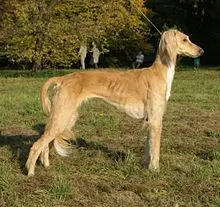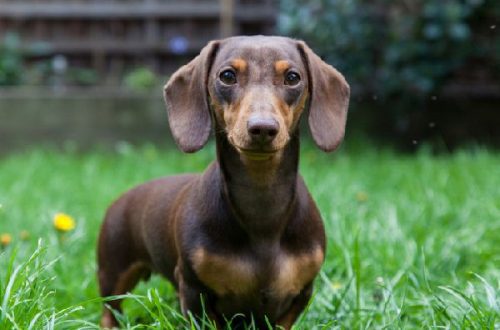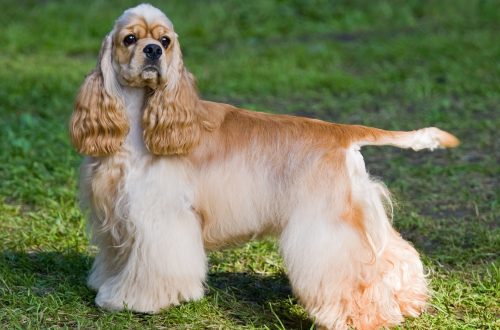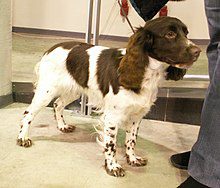
Russian Spaniel
Contents
- Characteristics of Russian Spaniel
- Pros and Cons
- Basic moments
- History of Russian Spaniel
- Description of the Russian Spaniel
- The nature of the Russian spaniel
- Education and training
- Maintenance and care
- Nutrition of the Russian Spaniel
- Health
- Photo of Russian Spaniel
- Who are these dogs for?
- Famous owners
- How to choose the right puppy
- Photo of Russian Spaniel puppies
- Owner’s personal experience
- Cost of a Russian Spaniel
- Video
Characteristics of Russian Spaniel
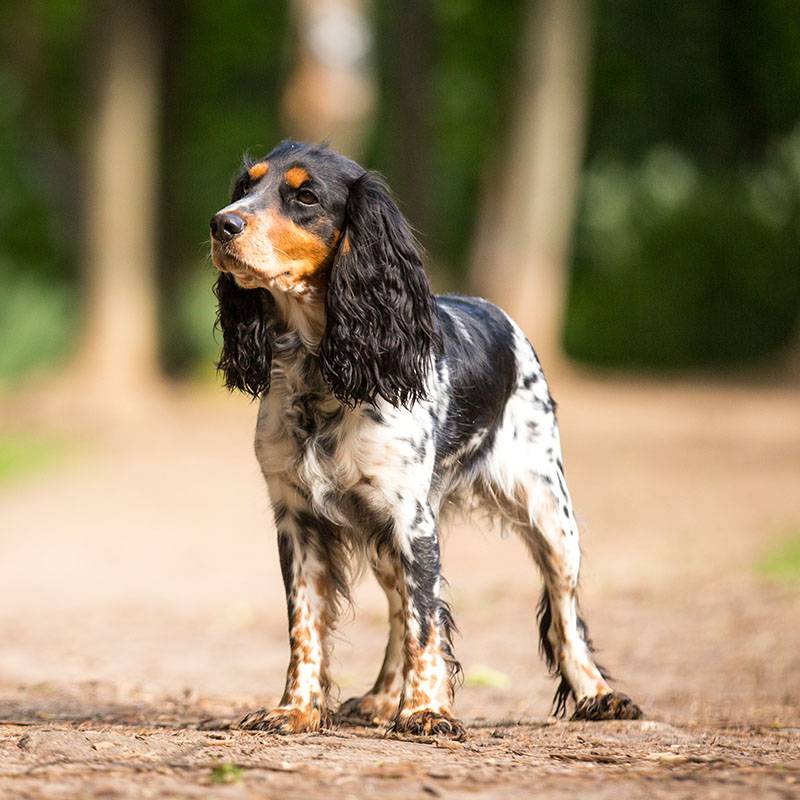
The Russian Spaniel is a hunting dog designed for hunting game birds. Smart, easy to train and very athletic.
| Country of origin | Russia |
| The size | medium |
| Growth | 15-18 kg |
| Weight | 38-45cm |
| Age | 2-14 years old |
| FCI breed group | not recognized by the FCI |
Pros and Cons
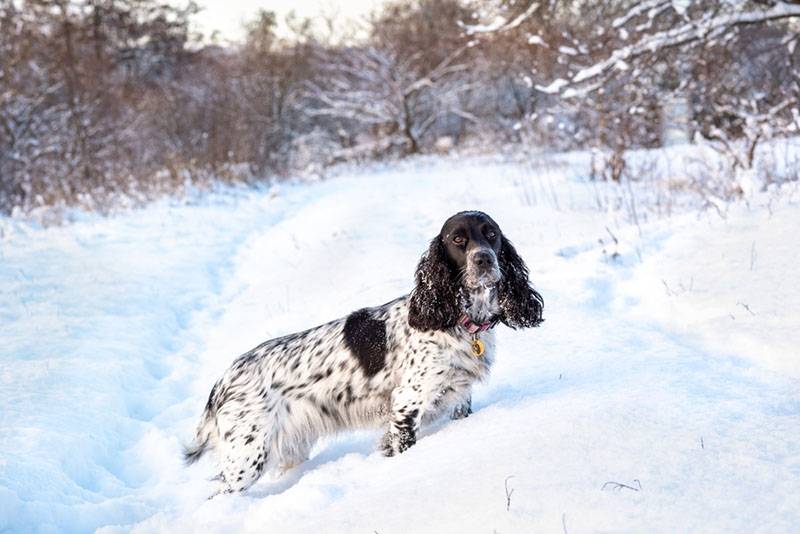
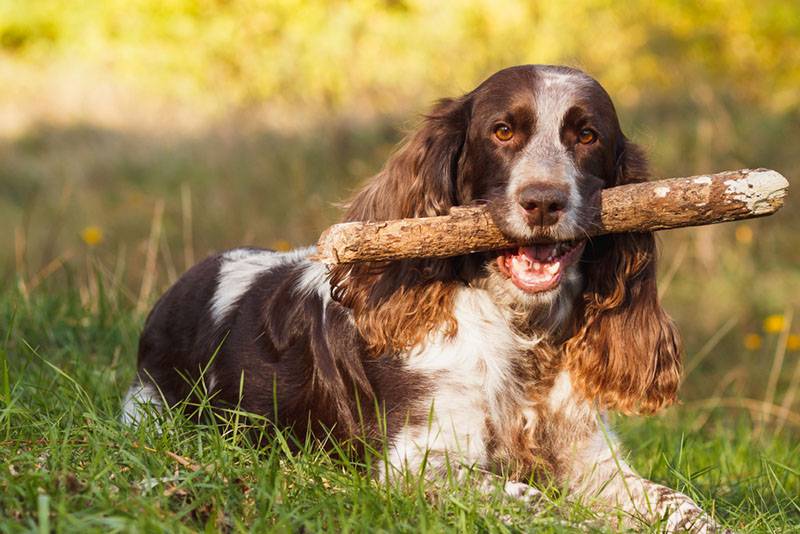
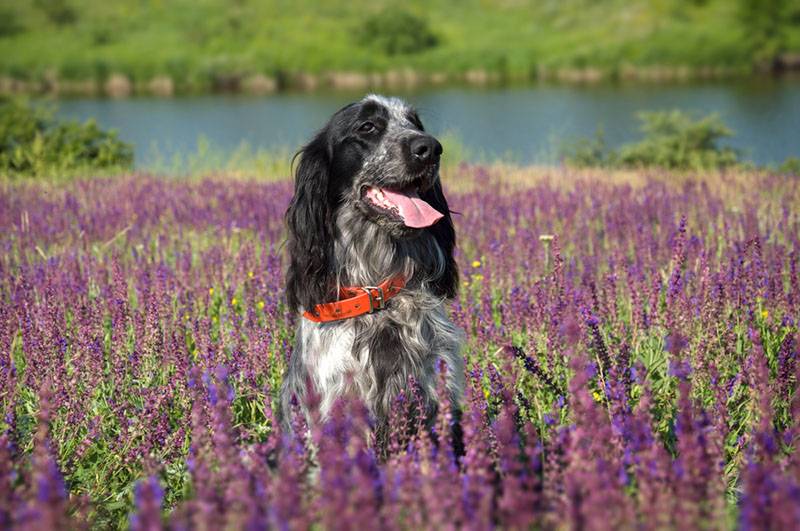
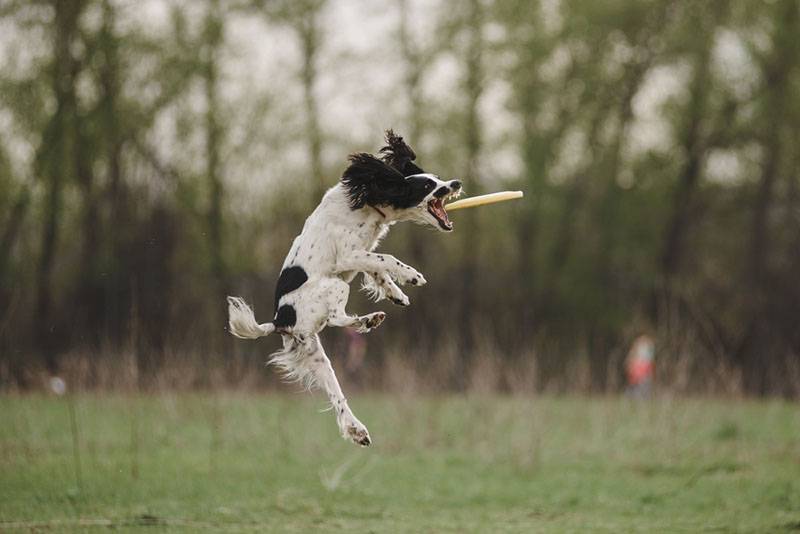
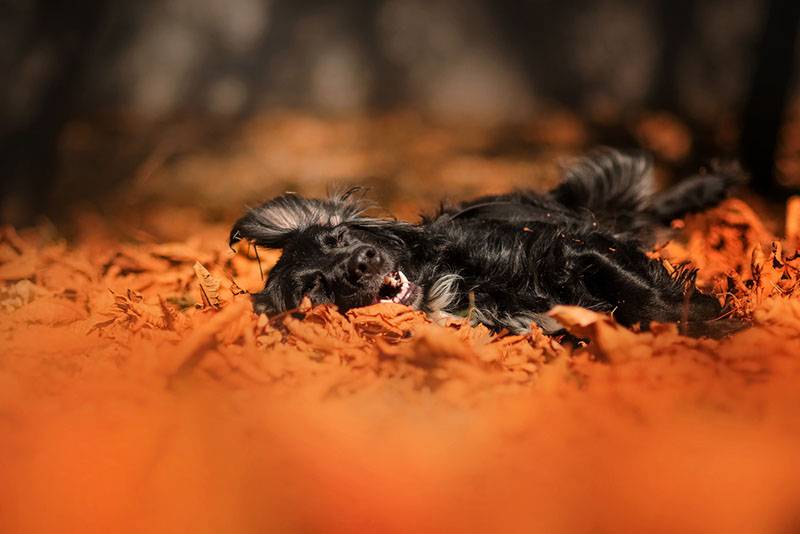
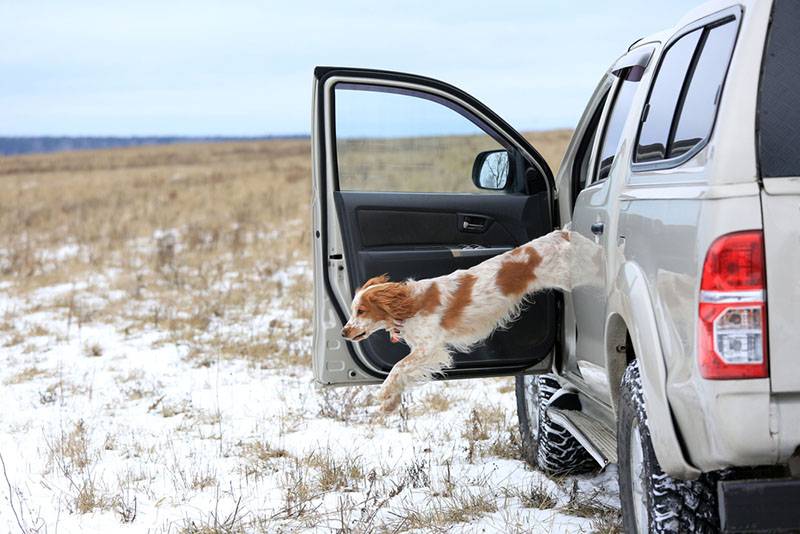
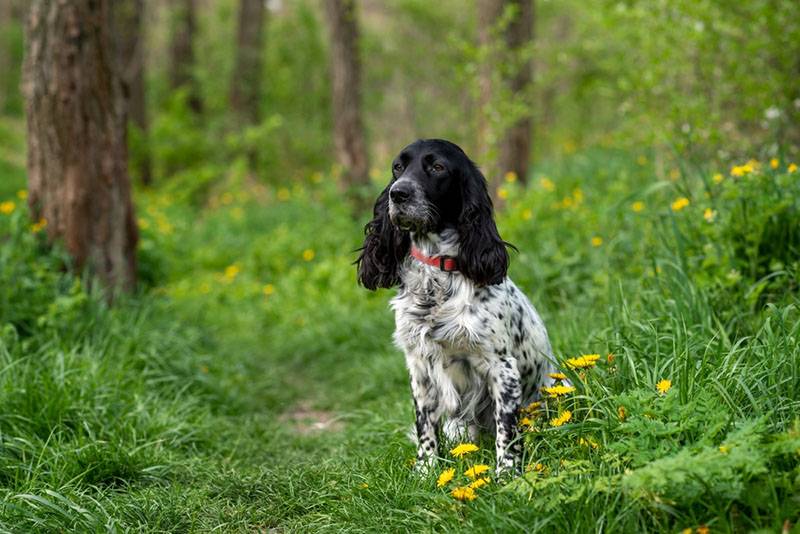
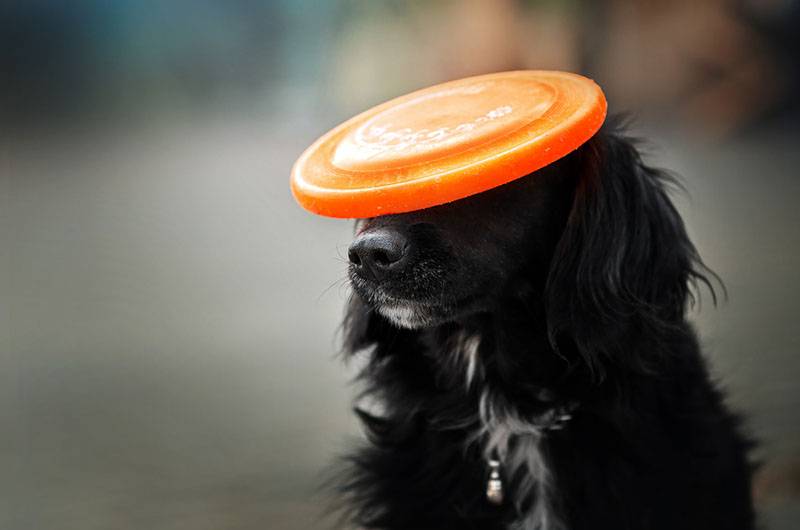
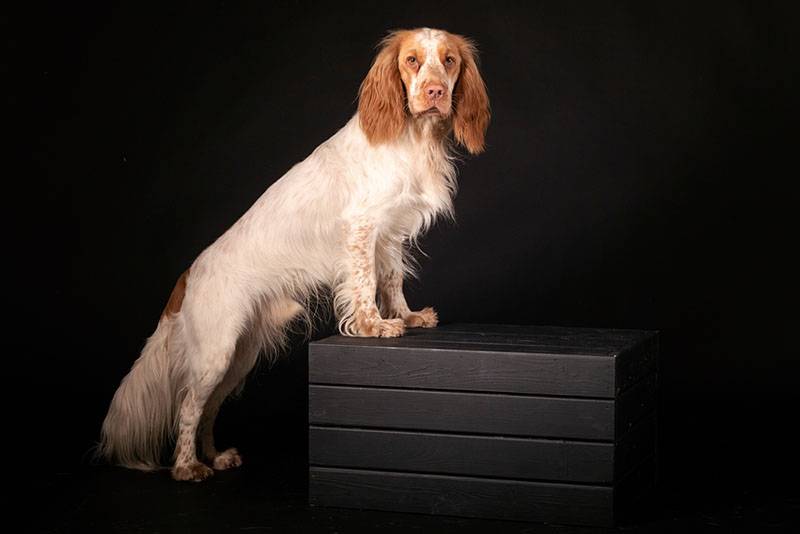
| PROS devotion to his master; They swim very well; Goodwill towards all people; Hardworking hunter. | CONS Too playful; Need a long walk; Can chase living creatures; Requires early socialization. |
Basic moments
- The breed is registered by the RKF, but has not received recognition from the International Cynological Federation. In 2002, for the convenience of foreign breeders, the Russian Spaniel Club (USA) was created, which registers litters abroad.
- Regardless of their hunting skills and lively temperament, Russian spaniels easily adapt to city life and are happy to make forays into nature in the owner’s backpack.
- The breeding of the breed takes place under the strict control of Russian breeding clubs, so most of the hereditary diseases have bypassed its representatives.
- Weather conditions do not affect the hunting talents of the Russian Spaniel. This dog can work perfectly with complete calm and even in the heat.
- The Russian Spaniel is a born tracker and earner. At the same time, with cats and other pets with which the dog grew up, he has a “non-aggression pact”.
- All representatives of the breed love to swim and are not afraid of cold water.
- The dog’s stomach is a “black hole” in which gigantic volumes of food disappear without a trace.
- Russian hunting spaniels are often used to search for psychotropic substances and locate people in emergency situations. According to domestic cynologists, this is one of the best breeds in terms of flair and persistence of the search.
- It is not forbidden to take a Russian hunting spaniel as a pet and companion, but it is very undesirable, since it is unlikely that it will be possible to provide the animal with the level of stress and emotions that work with game gives him.
History of Russian Spaniel
Russian hunting spaniel is considered the youngest breed of domestic hunting dogs. The first standard was published in 1951. Later adjustments were made, but very minor.
There is an erroneous, but very common opinion that this breed formed independently in the post-war years: Cocker Spaniels and Springers brought from other countries interbred with each other. But the version is completely unproven. After all, if you open the first all-Union breeding book of hunting dogs, then you can find photographs of dogs that were born back in the 1930s, and in appearance were no different from modern Russian spaniels. That is why experts say with confidence that the formation of the breed began in the pre-revolutionary years.
Although the word “spaniel” itself means “Spanish”, in fact, dogs do not have any Spanish roots. They were bred in England. The crowned persons were very fond of such long-eared animals and were actively engaged in their breeding. In particular, the monarchs Charles I and Charles II.
In our country, dogs began to be imported in the 17th century. But the name “spaniel” did not exist in those days. These dogs were commonly called “charlotte” (from the name “Carl”, pronounced in the French manner) or “Spanish dogs”. L.P. Saboneev, a researcher of hunting breeds, wrote in one of his works that “charlottes” were perfect for hunting birds.
For the first time such dogs in our country appeared as hunting dogs among the nobility. For example, the Grand Duke Nikolai Nikolaevich Romanov, the uncle of the last tsar. He was very fond of hunting, he created several hunting farms, including the famous Pershinsky Hunt. Nikolai Nikolaevich tried to acclimatize certain types of game in our state: in particular, he had a pheasant nursery.
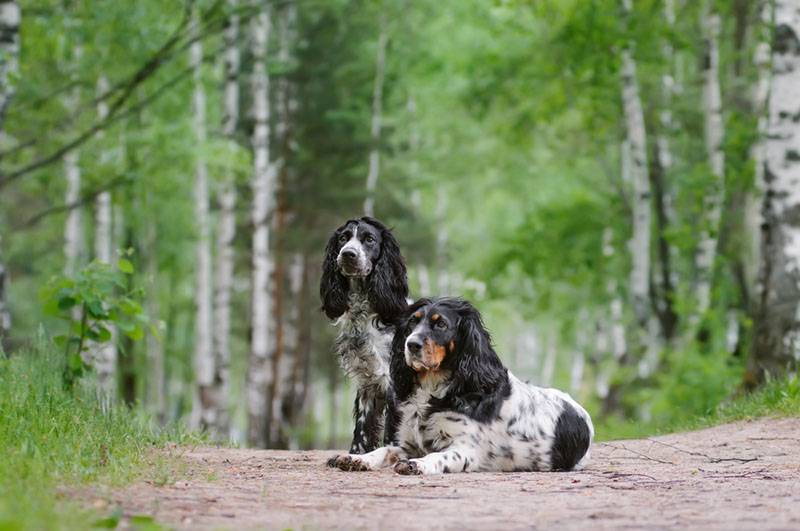
The beginning of the formation of the Russian Spaniel breed can be attributed to 1931. It was this year that a department dealing with such animals was organized in the Leningrad Regional Society of Blood Dog Breeding. Breeders worked to improve the breed characteristics.
The Second World War led to the fact that the dogs were almost completely destroyed. After its completion, the restoration of the population began. It was during this period that the appearance of dogs was finally formed, and the first standard was developed.
Among Russian hunters, the breed was very popular. In the 1960s and 80s, they hunted a wide variety of birds with it.
In the early 1990s, after such dogs began to actively participate in exhibitions, they began to start all over the country.
The Russian Spaniel Club was founded in 2002.
Description of the Russian Spaniel
The Russian Spaniel is a dog of small stature and a proportional, strong-dry physique. The body looks slightly stretched.
The muscles are well developed. The skin of the animal is smooth. The folds on it are a significant drawback.
The coat of the Russian Spaniel is double. The guard hairs are quite long and may be slightly wavy. The undercoat is very thick and dense, perfectly protecting the dog from adverse weather conditions.
Head
It has a moderate length in the dog. In relation to the body is fully proportional. Usually in females it is more elegant than in males.
If you look at the animal’s skull from above, it will have the shape of an oval.
The brow ridges of the Russian Spaniel are clearly defined. The occiput is almost invisible.
The nose is quite wide. His preferred color is black. In individuals of brown and brown-white coloration, a brown color of the lobe is acceptable.
The muzzle looks broad. Tapers a little towards the nose. Lips tight, dry. Their pigmentation usually corresponds to the color of the animal: it can be either black or brown. Cheekbones not protruding.
The jaws of the Russian Spaniel are strong. Teeth are white and even. A complete dentition should be 42 teeth. Bite – according to the standard, only scissors.
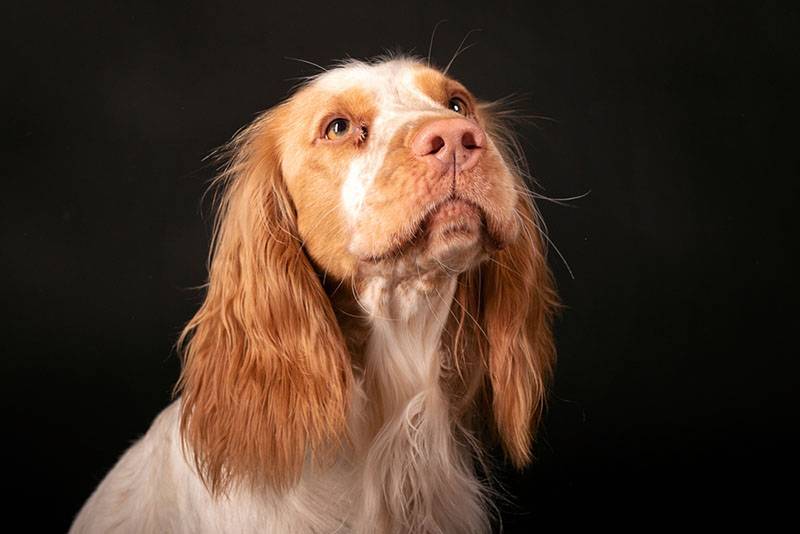
Eyes
They are of medium size. Their shape is oval. Set straight. The color of the iris should be dark: brown or dark brown.
A light brown iris can only be in animals with a light color.
The eyelids of Russian Spaniels are highly pigmented.
Ears
According to the standard, they should be set at eye level or slightly higher. They fit very well on the cheekbones. They widen considerably towards the bottom. Rounded at the ends. Their coat is long and slightly wavy.
When pulled, the edge of the ear should reach the dog’s nose.
Neck
It is of medium length in the Russian Spaniel. With well developed muscles. The coat on it is thick, sometimes wavy.
Frame
This part of the body looks strong and slightly elongated. The line of the back is sloping. The withers look well developed, especially in male pets.
The back is broad and powerful. The abdomen is tucked up. The chest is wide.
Tail
It is a continuation of the topline in the Russian Spaniel. It has a moderate length – approximately to the hocks. At the base – thick, towards the end – narrows. Its shape is saber.
When the dog is at rest, the tail is carried as a continuation of the line of the back. In an excited state, the dog lifts him higher. The tail of this breed is very mobile.
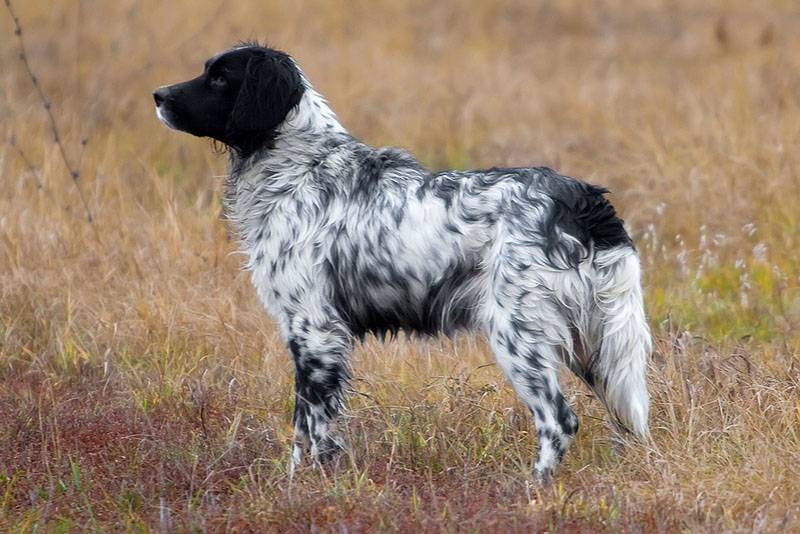
limbs
The legs of the Russian Spaniel look straight and strong. Their muscles are well developed. The articulation angles on the hind limbs are clearly expressed.
The dog’s paws are oval in shape. The fingers are of moderate length, tightly pressed together. Spaniels have thick fur between their toes. Claws, according to the standard, can be of any color.
Gait
The movements of such a dog are active and free. Fully balanced in any gait. When the animal begins to pick up speed, it switches to a gallop.
Wool
The coat of spaniels is thick and dense. Undercoat is present. The outer hair is smooth and long. May be slightly wavy. Short hair on muzzle and front of legs. On the neck, back and sides – has a moderate length. There are feathers on the limbs, tail. Between the toes of the paws, the hair is thick, forming a kind of “brush”.
Russian spaniel color
According to the standard, the colors of Russian hunting spaniels are solid, piebald and spotted.
Solids include:
- Black;
- redheads;
- brown;
- Black and tan;
- Brown with tan.
Piebald and spotted colors are:
- Black and white;
- Red and white;
- brown and white;
- Black and white with tan;
- Brown and white with tan.
Spotting is normal and can be either thick or sparse.
In solid colored dogs, small white spots on the chest, throat and paws are acceptable.
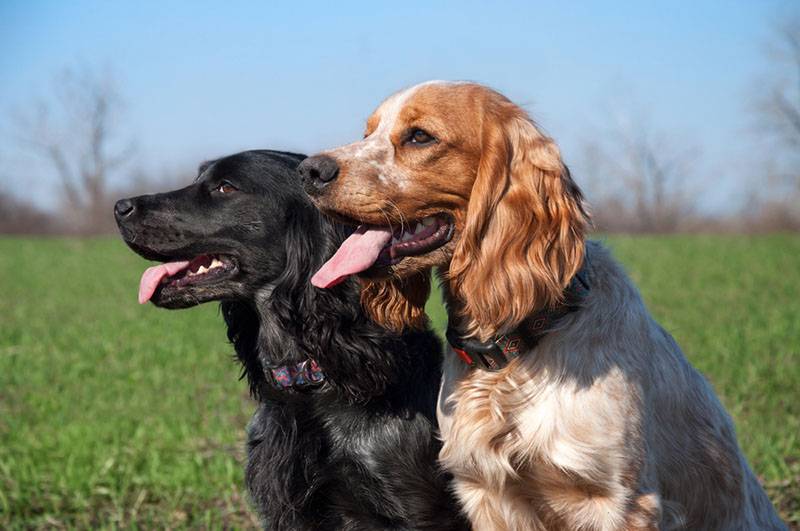
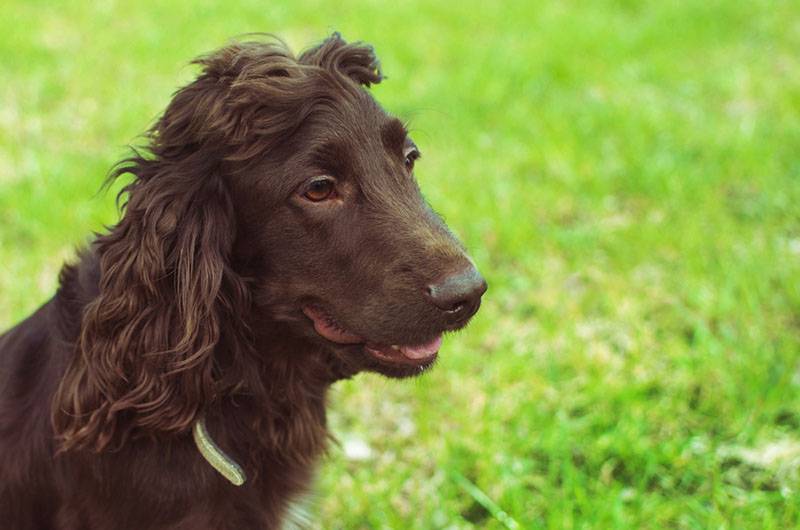
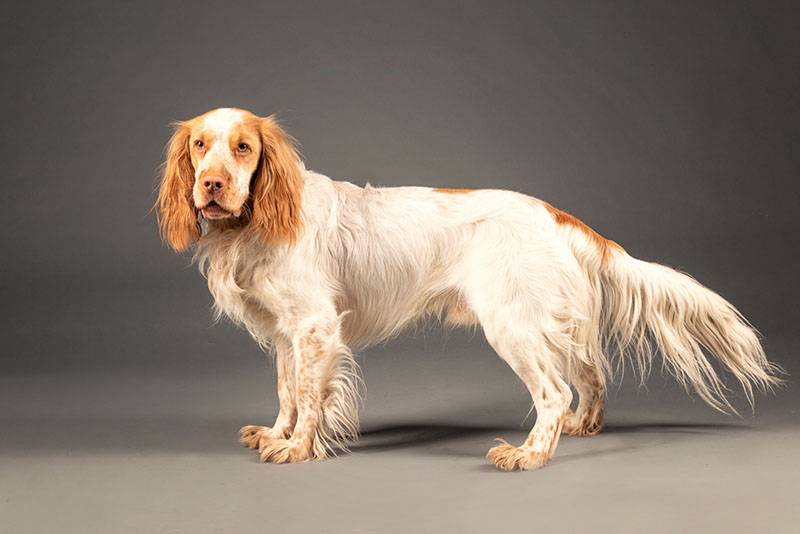
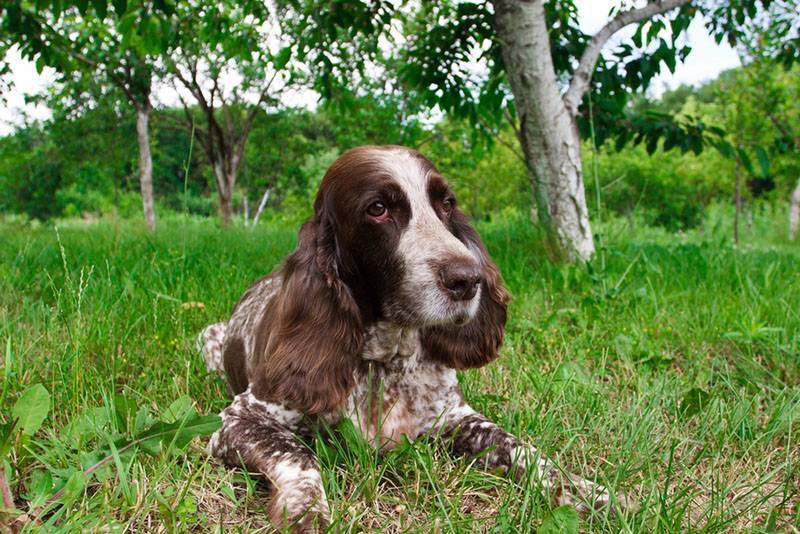
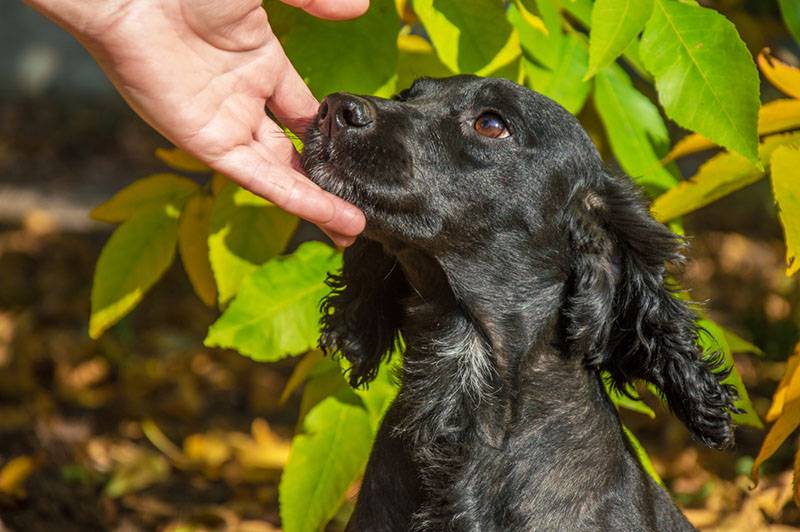
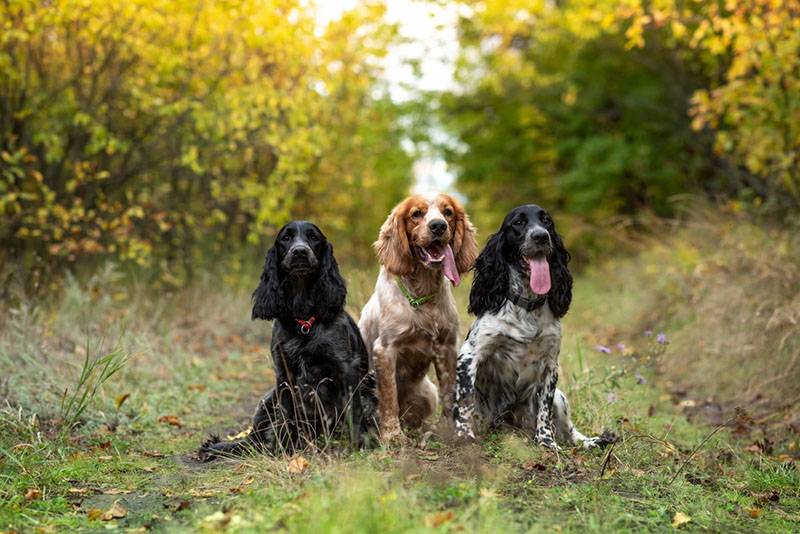

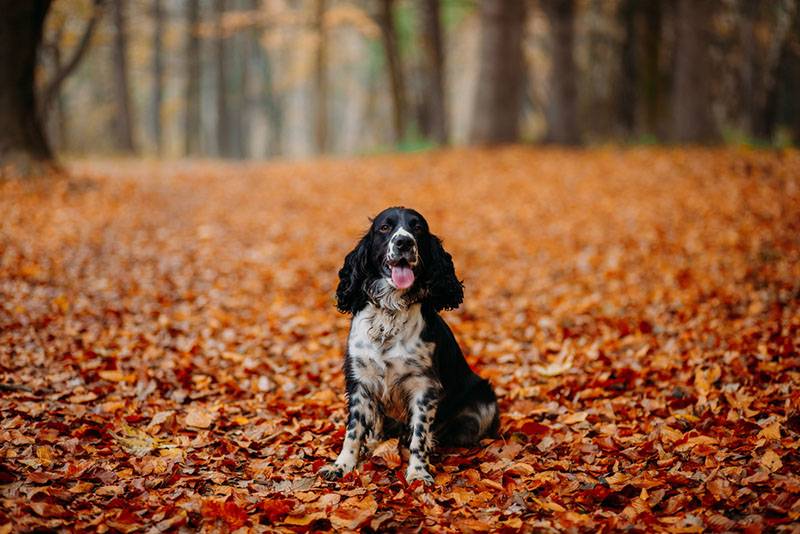
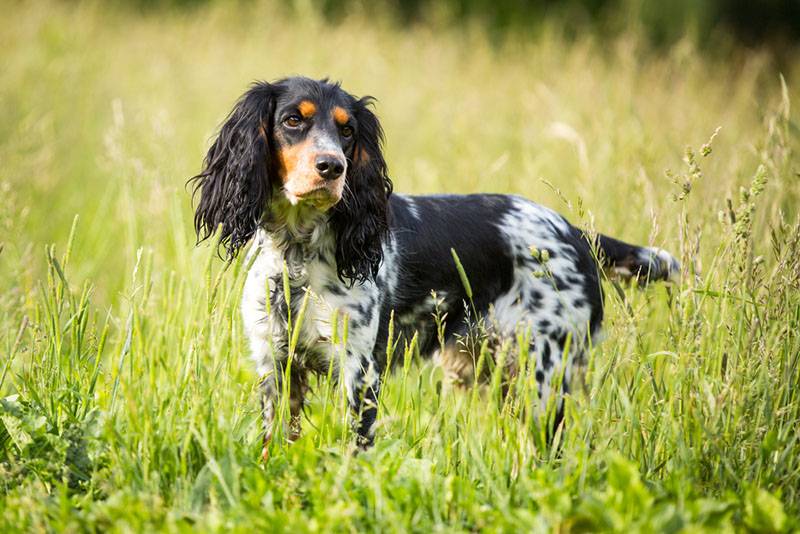
Size and weight
According to the standard, the ideal height for male Russian Spaniels is 40-45 cm, for females – 38-43 cm.
The average weight of dogs is from 15 to 18 kg.
The nature of the Russian spaniel
Russian spaniels are not only excellent hunters, but also good companions.
Such dogs are characterized by immense love for the owner. They are very devoted to him and ready to carry out all his commands. If the owner is away for a long time, the dog will miss him greatly.
To other people, including strangers, the pet will be calm. Aggression is not characteristic of him. With other dogs on the walking area, he behaves friendly, practically does not enter into conflicts.
Russian hunting spaniels are very fond of children. Can support any active game: hide and seek, catch up, search for a hidden object. In any case, parents should not leave their children alone with their pet for a long time. Constant supervision is needed even for an extremely friendly dog.
In addition, children must clearly understand how to properly behave with an animal: in no case should it be intentionally offended.
Often it may seem that such pets are overly loving. They often strive to lick a person’s hands and face, try to jump on his knees. It is necessary to wean a dog from a bad habit from a very early age.
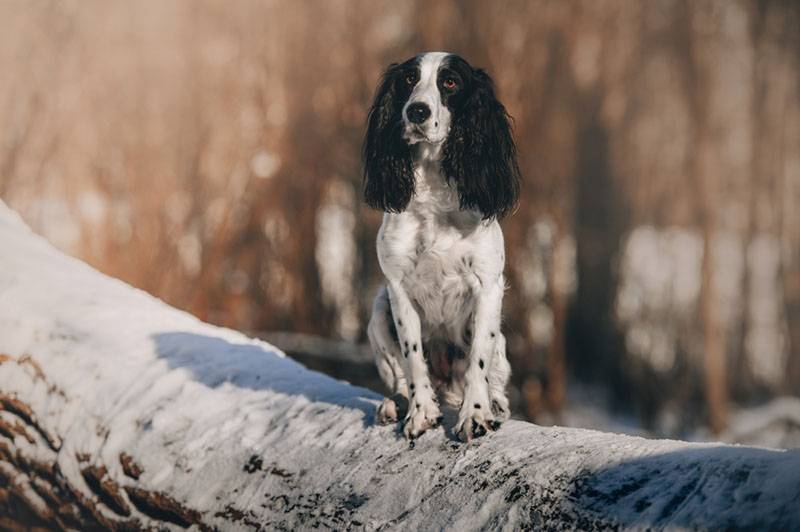
The Russian Spaniel will be happy to keep his owner company if he decides to walk around the park on a bike or just on foot, go to the forest for mushrooms or go fishing. Camping for Russian Spaniels is an ideal pastime. If the weather permits, then at least once every 1-2 weeks the dog is taken outside the city for walks and runs. In addition, these pets swim and dive superbly. They will like the rest by the river or lake.
Moreover, animals feel great in nature and in the winter season. They are very fond of running through fluffy snowdrifts, they are not afraid of the cold, because they were bred specifically for our climatic conditions.
With proper upbringing and timely socialization , Russian hunting spaniels feel great in crowded places. They behave calmly in public transport. They also love to drive cars.
Animals are very active. The energy from them literally abounds. That is why in order to splash out the energy reserve, you need to do physical exercises with a dog often and a lot. Otherwise, the dog may start playing pranks: for example, chewing on things in the house.
Pretty athletic. Often take part in various dog competitions.
As watchmen, Russian hunting spaniels are usually not used, since they have almost no aggression towards people. It is also not recommended to settle them in the aviary, since the dogs need constant contact with the owner.
How true hunters can chase small animals and poultry. Spaniels are taught to socialize with other pets from an early age.
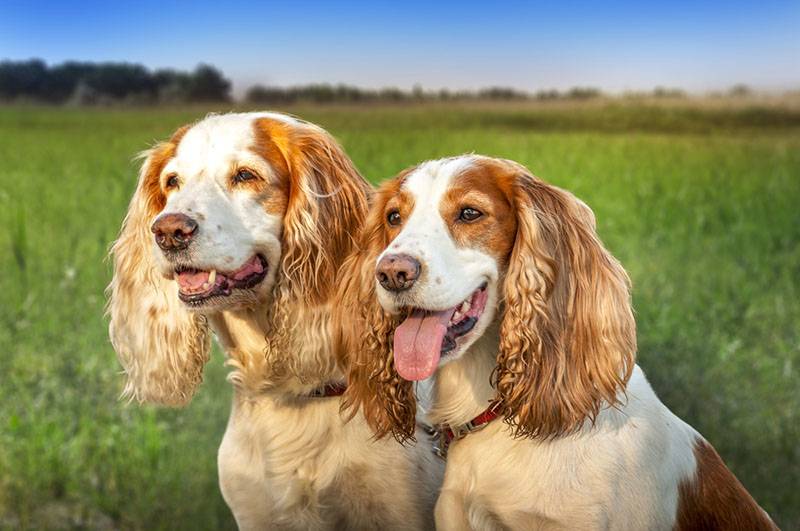
Education and training
Enough time is devoted to the upbringing and training of any dog.
Russian hunting spaniels are smart and quick-witted, so they pick up new skills and commands on the fly.
Although sometimes they are capable of being stubborn, like the bulk of hunting dogs, prone to making their own decisions. Therefore, the owner needs to be patient and strive to stand his ground: every command given to him must be executed, there should be no concessions.
Education can start at an early age. Already at the age of 1.5-2 months, the baby is able to master the simplest set of skills: toilet training , nickname, own sunbed and dishes.
Each dog owner should clearly understand for himself that training should not be limited to mastering a set of commands. This concept is much more complicated. Education is understood as the correct behavior of the animal at home and in public places. A well-bred dog will never bark at passers-by, transport, endlessly pull the owner by the leash .
It is necessary to prepare for the appearance of a new resident of the house – a puppy – in advance. While the baby is still very small, it is important to remove all things and objects that are dangerous for him. For example, close sockets with plugs, remove wires higher, put trash cans in an inaccessible place. Flower pots are also best removed higher, especially if these plants are poisonous to dogs.
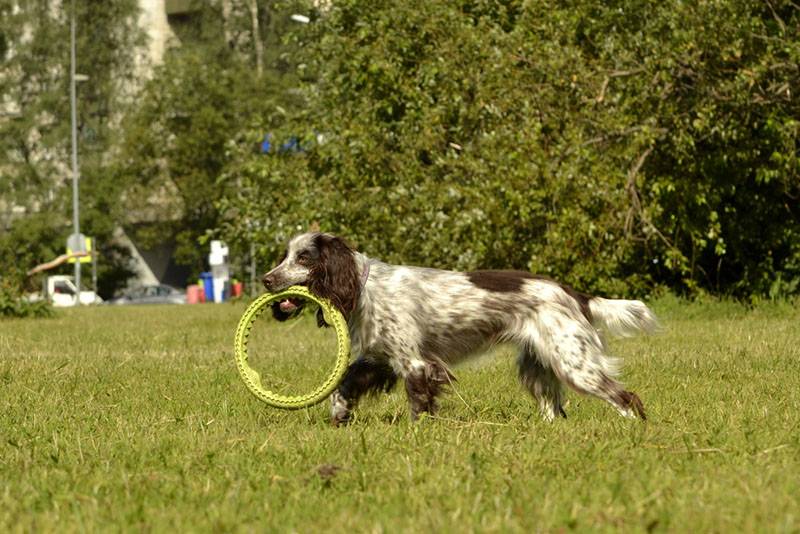
It is recommended to mark the boundaries of what is permitted for a pet from the first days. For example, if you plan that the animal will by no means sleep on your bed, then you need to explain this to him right away.
The bed is prepared in advance. It must be the right size for the dog. The bed should be in a secluded place so that the spaniel can rest there. It is undesirable for the sleeping place to be organized, for example, on the aisle. In addition, the lounger should not be located in a draft, as the dog can catch a cold.
Rewards are very important in the learning process . To do this, they use both verbal praise or affection, and delicious delicacies. It is not recommended to give the dog foods that are harmful to it as treats: sausage, sausages, cookies, buns, sweets. It is best to give dry food as rewards for completed commands. It is easy to use (you can take it with you on walks) and is good for your pet.
For Russian Spaniels to be used as workers, it is important to learn specific commands. It is also necessary to start studying them from an early age. The most important command is “Aport”. You can train an animal to bring various things at home. To begin with, a two-month-old baby must master the “Lie down” command, since the dogs must bring game to the hunter after a short exposure. The exposure interval time increases from a few seconds to 2 minutes as learning progresses. After that, the dog is given the command “Forward”, “Give” or “Fetch”, and she brings the thing. When the puppy takes it in his teeth, you need to say the command “Give”.
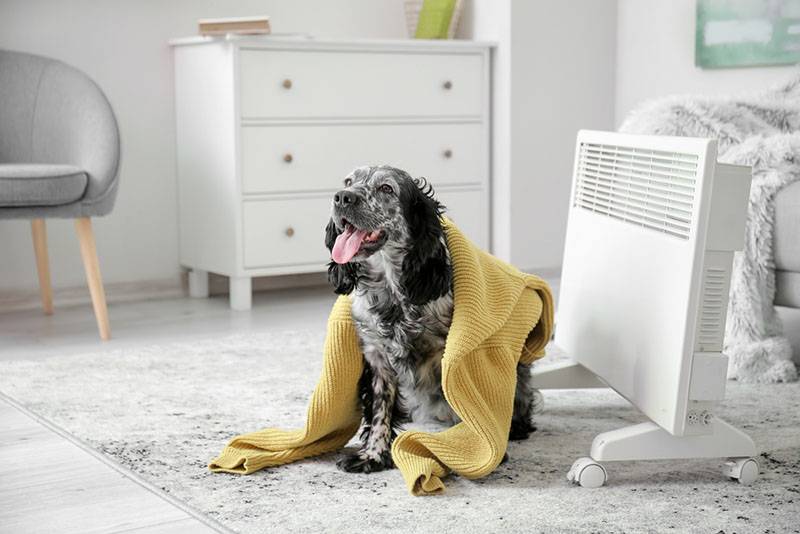
Maintenance and care
The Russian Spaniel is a medium sized dog. Therefore, it is suitable for living in a city apartment. Although the ideal option for her would still be considered a private country house with a fenced area for regular walking.
If a decision is made to keep the animal in the city, then, if possible, it should be taken out to the forest for walks, and also taken outside very often. Physical activity should be constant.
The dog’s long coat requires regular brushing. It is better if the procedure is carried out daily with a special comb.
It is desirable to cut a pet for the first time at the age of 2 months. After that, as needed. Hair is cut off on the stomach and paws. The hair on the back must not be touched.
Washing your dog too often is not recommended. Usually once a month is enough.
When it is dirty outside, you will have to wash the tows on the limbs and stomach with warm water.
In winter, soap is used to wash paws, as roads in cities are sprinkled with salt and sand. These substances can irritate your dog’s pads. Also, to protect the paws of the animal, it is recommended to use protective waxes. They coat the pads with them before going outside and remove it immediately upon arrival home.
Pet teeth need careful care. To prevent plaque, tartar and caries from forming on the enamel, they are cleaned daily. You can use a toothbrush for this, which is selected according to the size of the mouth. For puppies buy a fingertip (special or children’s). Toothpastes for dogs are used by veterinarians, ordinary human toothpastes are not suitable for them, since many substances that are harmful to animals have been added to them.
Pets living in the city and often walking on the pavement rarely cut their claws , since they usually grind themselves on the road. The rest of the dogs are sheared every two weeks with special cutters.
If the owner does not have experience in cutting nails, then for the first procedure, you can go to the groomer. He will show you how to cut the claw correctly: which part of it should be removed and which part should be left. This is very important, because each claw contains a blood vessel and nerve endings that must not be touched.
Pet ears should be cleaned with veterinary lotions. It is undesirable to use baby creams, boric alcohol or peroxide for this.
After walking and every trip to nature, the pet should be checked for ticks. Especially often parasites can be found in the period from March to October. The check usually starts at the muzzle and then moves on to the body. It is important to carefully examine all skin folds.
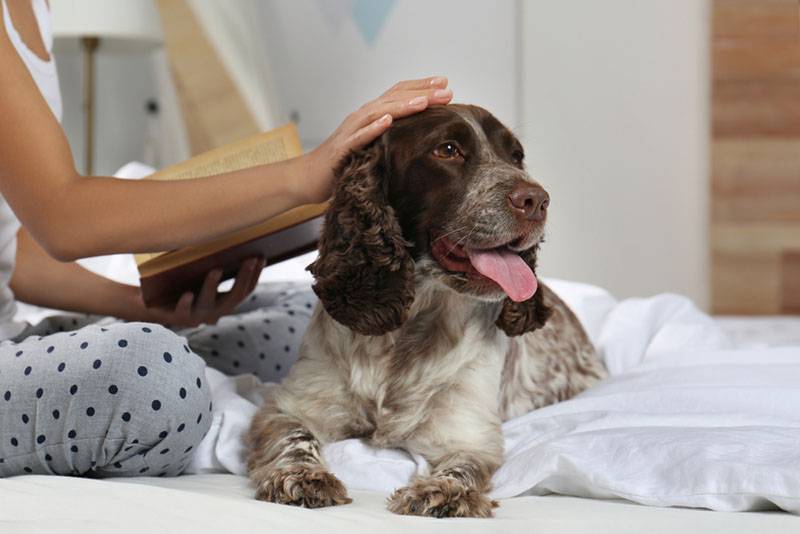
Nutrition of the Russian Spaniel
Both a puppy and an adult dog should be well fed . A properly selected diet of the Russian Spaniel will keep the adult animal in excellent physical shape, and the baby will ensure full growth and development.
A four-legged friend of a person cannot be fed from the master’s table. The dog should be cooked separately, because the needs of his body are completely different.
The dog’s metabolism is focused on ensuring that the basis of the pet’s diet is protein products. It is in this case that the stomach and intestines will work in the correct mode. The animal must also eat carbohydrates, but in very small quantities. You need very little fat – about 4-5 ml per day. Vitamins and minerals are also extremely important.
A specialist, that is, a nutritionist, should draw up a nutrition plan for any dog. It is wrong to assume that you can read the relevant literature, study the information on the package with an industrial ration and start feeding the animal yourself. The body of each pet is individual. Everyone has their own weight, lifestyle, age . There are dogs that have chronic illnesses. Therefore, the diet is calculated individually after visiting a professional nutritionist.
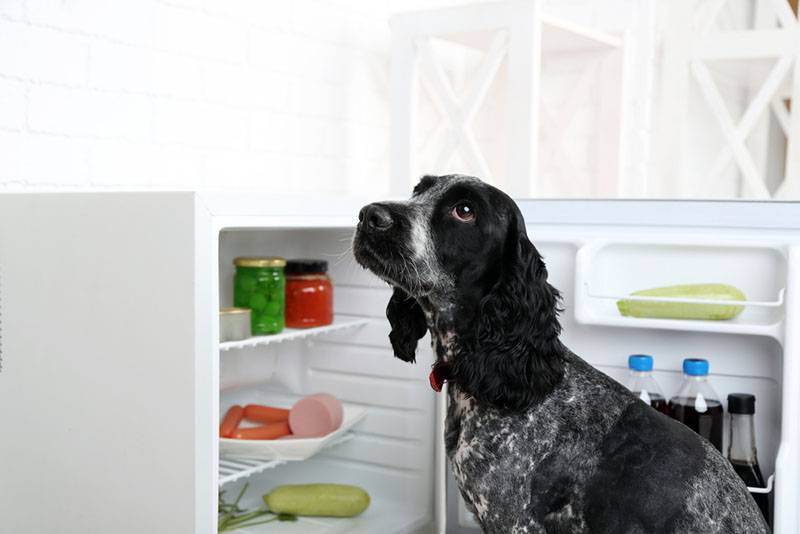
The specialist will help the owner decide what type of food to choose:
- Natural products;
- Ready industrial rations.
The first feeding option is quite difficult. In this case, you will have to buy a lot of food for the dog, cook them yourself. Special attention should be paid to the quality and freshness of products. Under no circumstances should you give your pet expired food.
You will have to calculate the content of proteins, fats and carbohydrates in each serving daily. The calorie content of the dish will also need to be taken into account. For these purposes, it is advisable to purchase a kitchen scale.
The use of vitamin and mineral supplements with a natural type of nutrition is mandatory.
Vitamins are prescribed only by a specialist.Industrial feed can be complete and non-complete.
The first do not need to be supplemented even with vitamins. Vitamins and minerals are not included in the composition of incomplete feeds, so they will have to be purchased separately. Ready-made rations are the easiest option for the owner.
If the second type of food is chosen, then the owner will only have to measure the pet a certain portion size for each meal. You don’t need to cook anything on your own. Dry food can be stored outside the refrigerator. It is very comfortable. The main thing is to hermetically close the used pack.
Your pet should be taught to feed from an early age. Puppies eat often – from 3 to 5 times a day. Adults usually eat 1-2 times. After eating, the bowl of food should be removed. The dog has free access only to water. Always make sure that the water in the bowl is always carefully. Especially pay attention to this in the hot season, when the pet drinks more often.
During feeding, the long ears of Russian Spaniels are better to be collected with an elastic band or put under a hat. This will keep the hair on them clean.
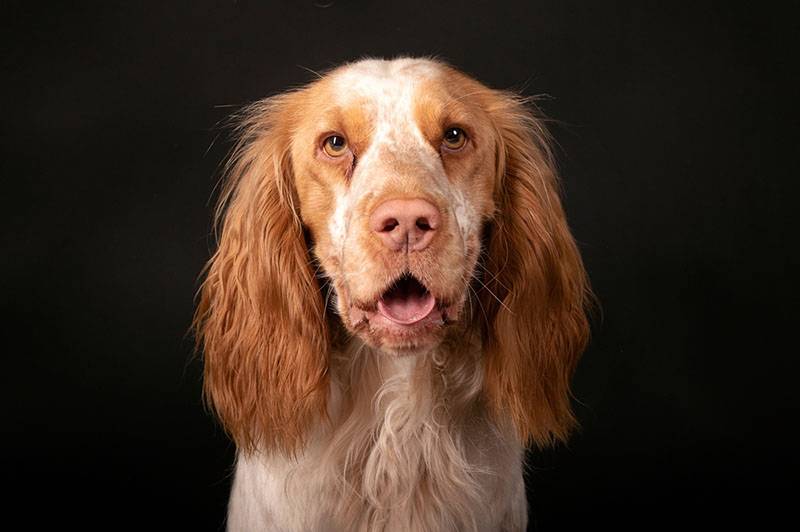
Health
Usually hunting types of dogs are distinguished by good health. But some types of diseases in Russian spaniels are still diagnosed:
- Inflammation in the ears;
- Cold.
Since the animal’s ears are very long, it is necessary to check them for inflammation regularly. The owner should always be alerted by the unpleasant smell of their auricles. If any problems are found, it is recommended that you contact your veterinarian as soon as possible.
In addition, Russian hunting spaniels are prone to gaining extra pounds because they do not know how to control their appetite. In order for the dog not to become obese, its diet must be compiled by a nutritionist.
At an early age (from 1 to 5 months), food allergies can appear in animals. Particularly chicken and carrots.
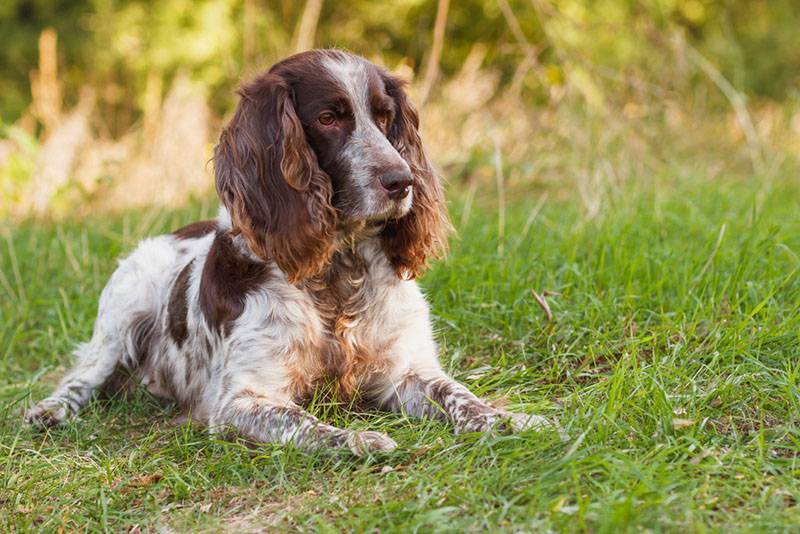
Russian Spaniels, who regularly go hunting with their owners, need to be carefully looked after. Check them for:
- Ticks;
- Dislocations and bruises;
- fractures;
- Burns, etc.
Each hunter must have a special first aid kit with him, which should contain bandages, tourniquets, antiseptics, and painkillers.
Photo of Russian Spaniel
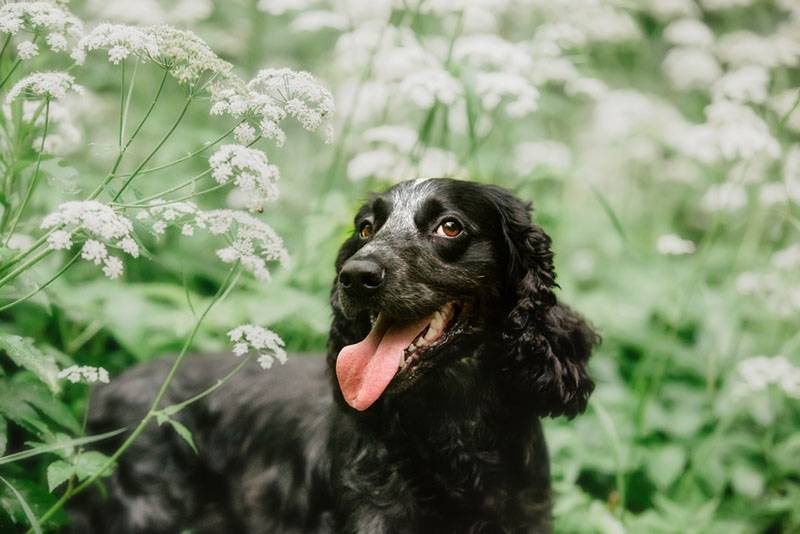
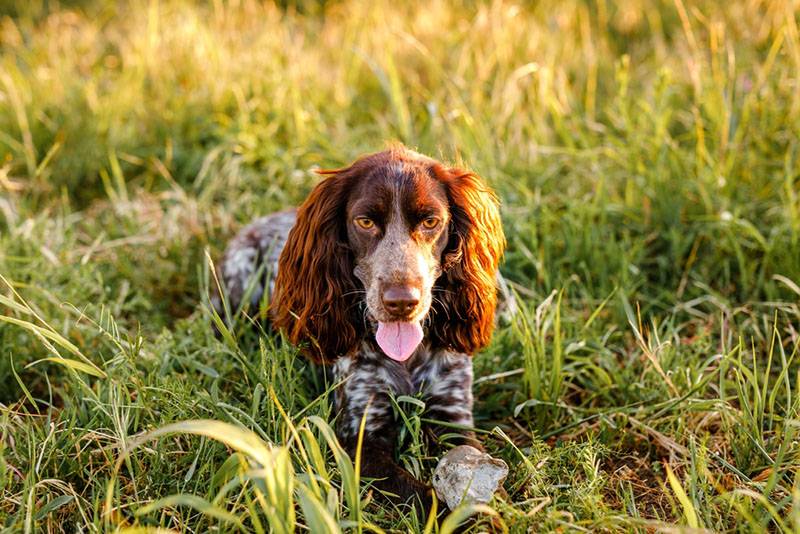
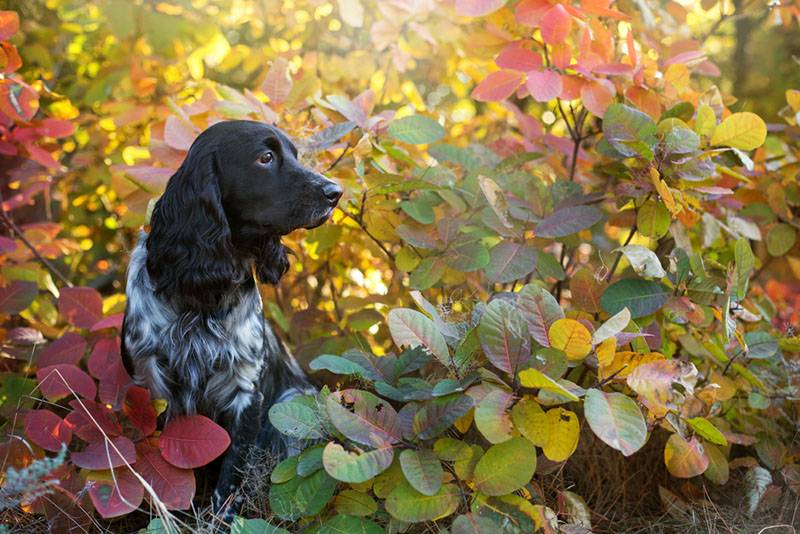
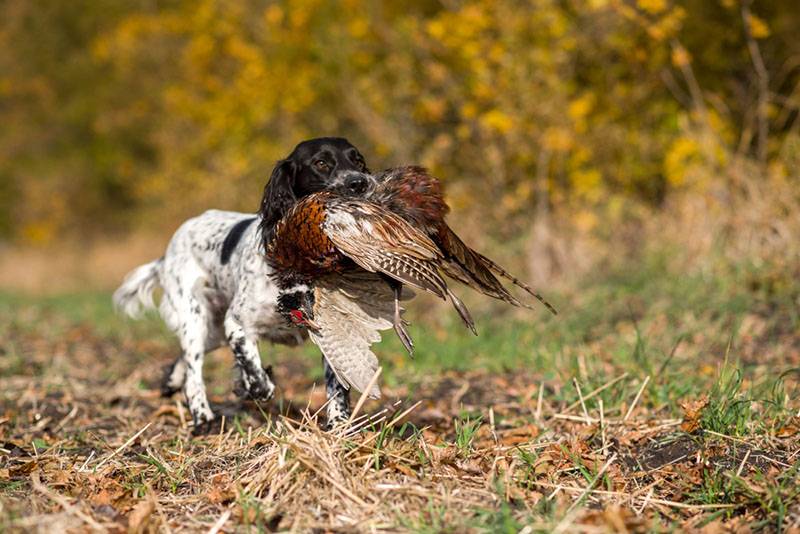
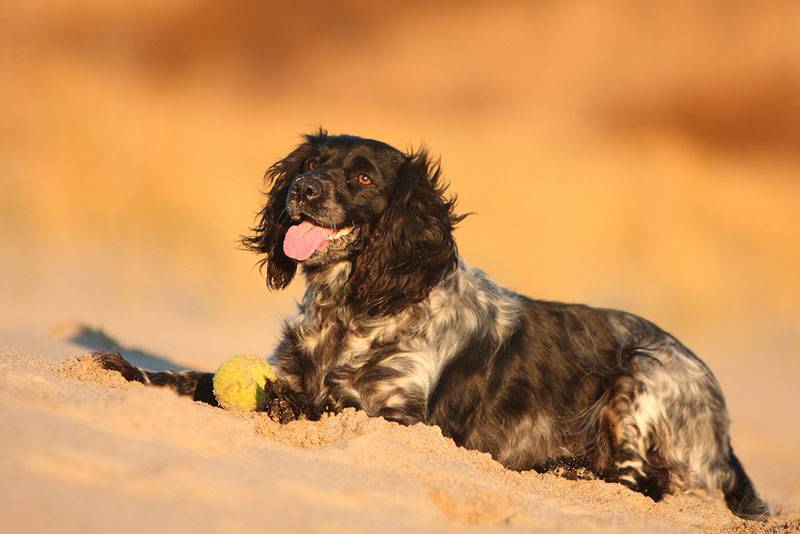
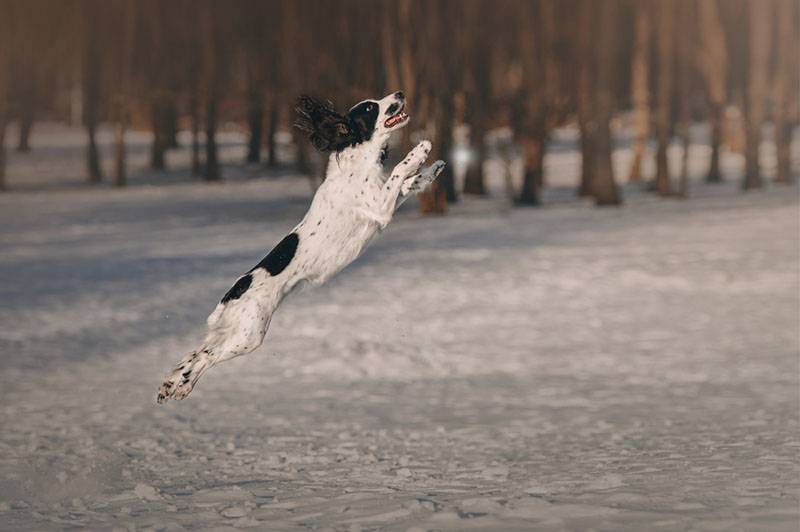
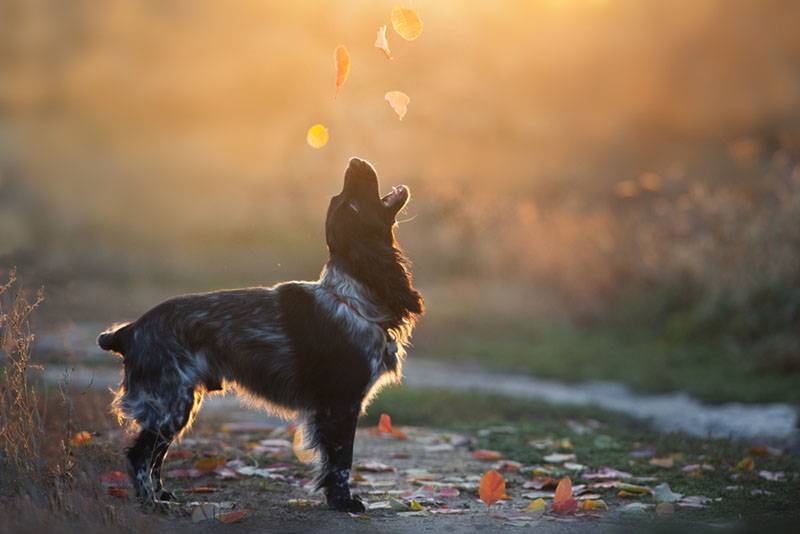
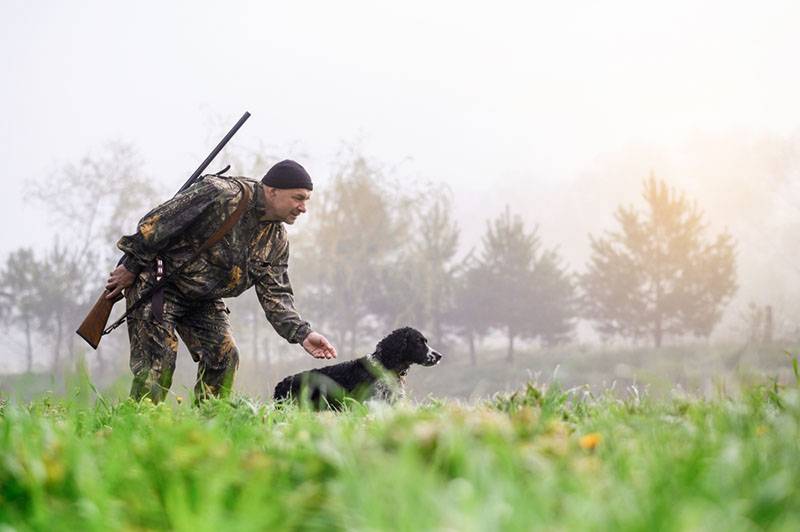
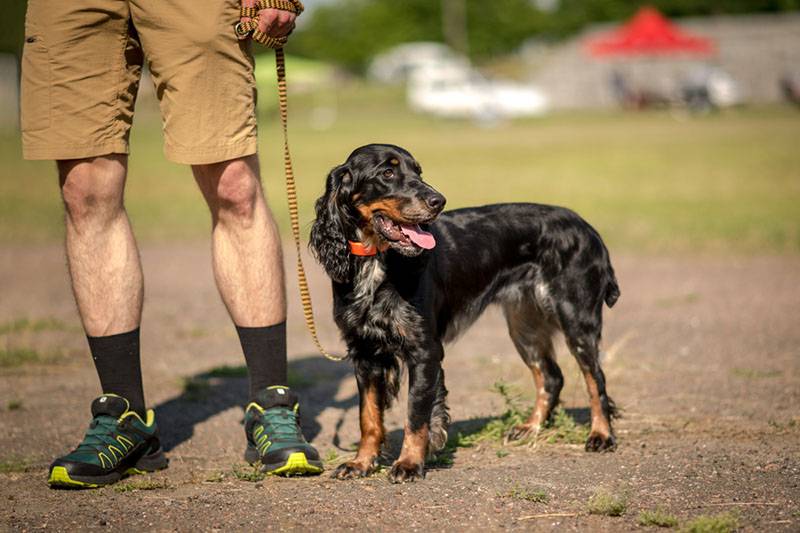
Who are these dogs for?
The Russian Spaniel is suitable for an owner who:
- Is a hunter;
- Prefers an active lifestyle;
- Likes friendly and non-aggressive pets;
- Dreams of a companion dog.
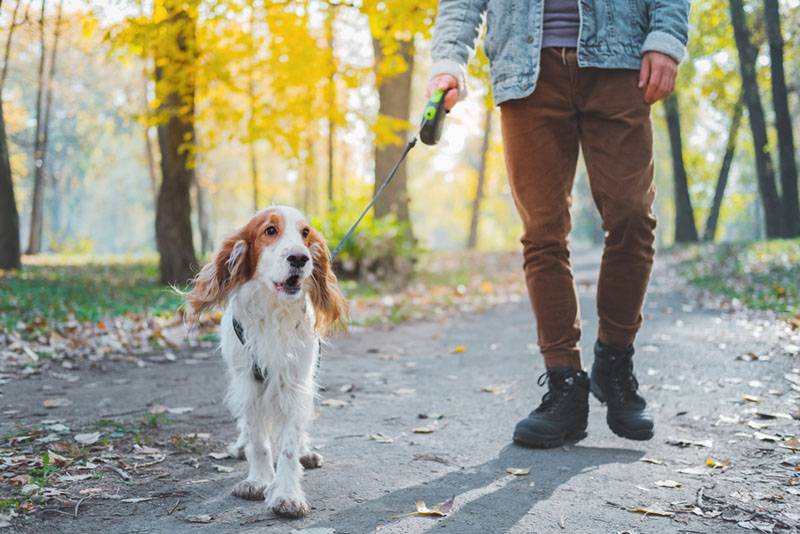
The breed is not suitable for people:
- Very busy, constantly disappearing at work or school;
- Not ready to walk a lot with the dog, go with her to the forest, to the river;
- Who dream of a calm pet.
First of all, of course, Russian spaniels are hunters. That is why the ideal owner for them will be a hunter, both young and old.
In addition, a dog can be brought to active families with children who prefer outdoor recreation.
For people who appreciate a measured and secluded lifestyle and sit at home a lot, a Russian hunting spaniel will not work.
Famous owners
It is known that the writer Mikhail Mikhailovich Prishvin was very fond of Russian spaniels. He had 4 such dogs. The spaniel was dedicated to the writer’s story called “Matchmaker”.
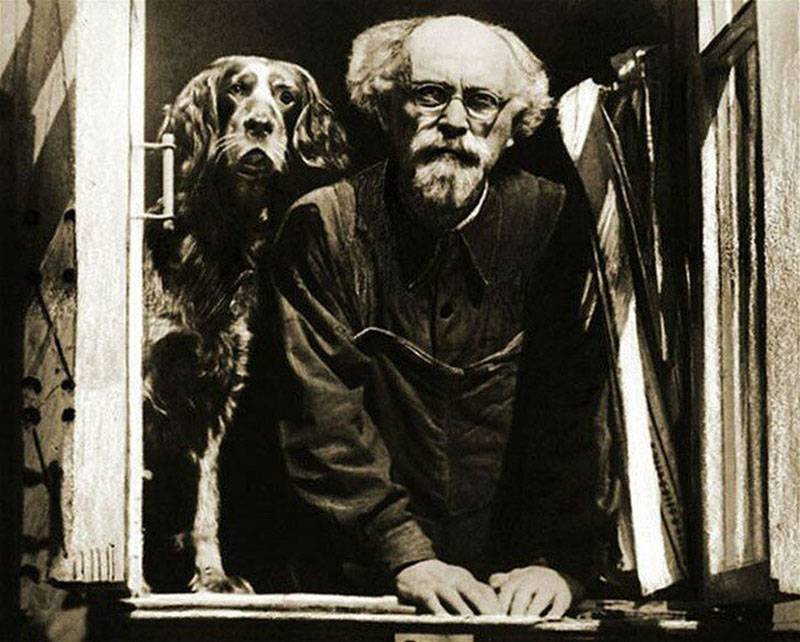
How to choose the right puppy
Before choosing a particular breed, it is recommended to study in detail the literature about it, if possible, communicate with owners, breeders, cynologists. If you have clearly decided that the Russian Spaniel is exactly what you need, then start looking for a nursery or a private breeder.
The ideal option is to contact a professional nursery with a good reputation. Specialists of such an organization will not only help you choose a healthy puppy, but also give advice on its maintenance, upbringing, and feeding. If you get a dog for hunting, they will tell you how to properly raise a working dog.
In addition, the following documents are always issued in the nursery:
- Veterinary passport;
- Metrics.
The first document has all the necessary information about the puppy’s treatments and vaccinations . The metric is subsequently exchanged for a pedigree.
You can also purchase an animal from a private breeder. But the probability of buying a thoroughbred individual in the nursery is much higher.
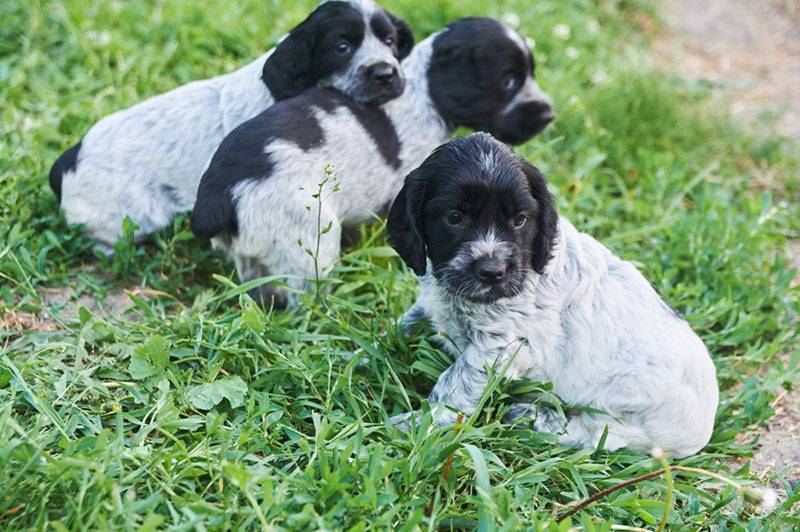
When choosing a Russian Spaniel puppy, ask the breeder who the parents of the babies are. Ask to see their papers. The organization that issued these papers must be a member of the RORS (Russian organization dealing with most hunting dog breeds) or RKF. If you wish, you can ask the breeder to make copies of the documents to show them to your specialists. If the nursery worker refuses, you should be wary. Most likely, they want to deceive you.
The majority of nurseries in our country mark their wards with a stigma – a unique code that helps to identify the animal if necessary. Often a chip is implanted instead of a brand.
The puppy should also be carefully examined. His legs should be straight and strong, his stomach soft (tight usually indicates the presence of parasites), his eyes clear and clean, his ears free of signs of inflammation.
It is worth paying attention to the behavior of the baby. The dog should not be afraid of strangers, hiding from them. A healthy dog is active and mobile, he is interested in everything that happens around him.
Photo of Russian Spaniel puppies
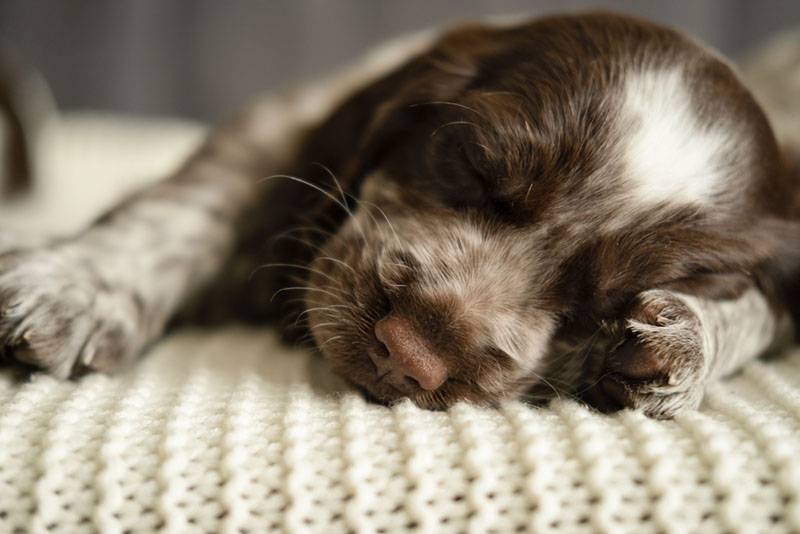
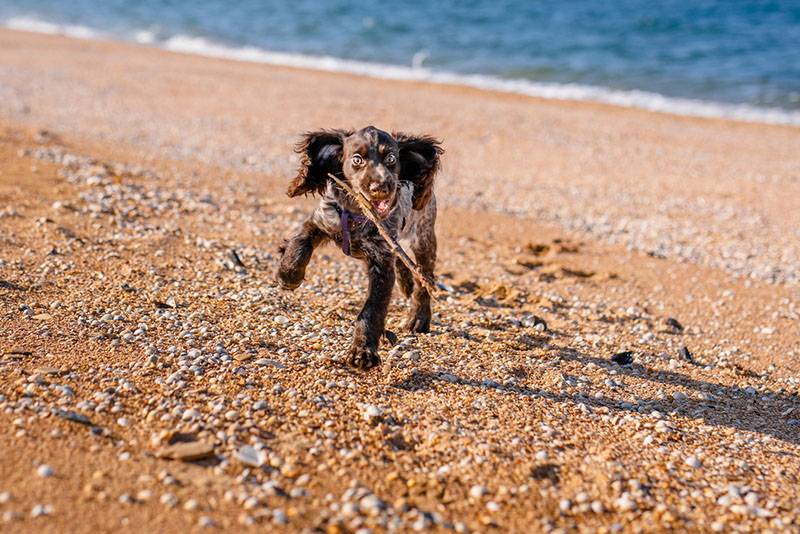
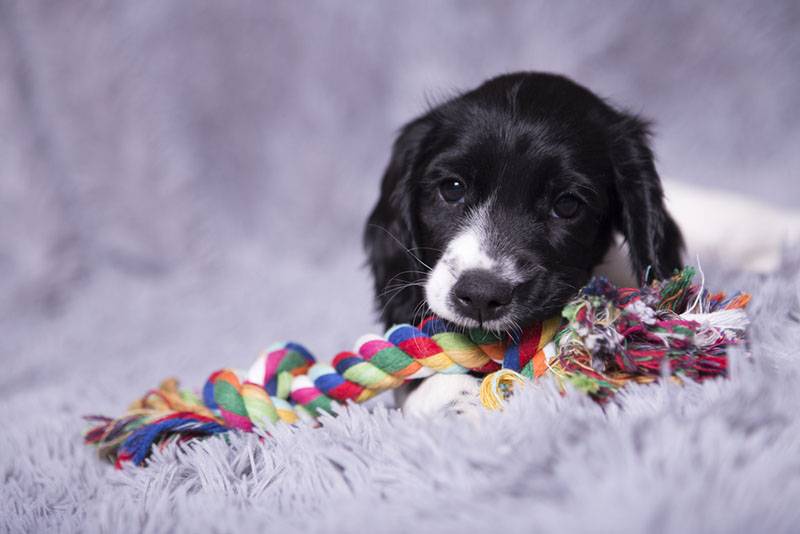
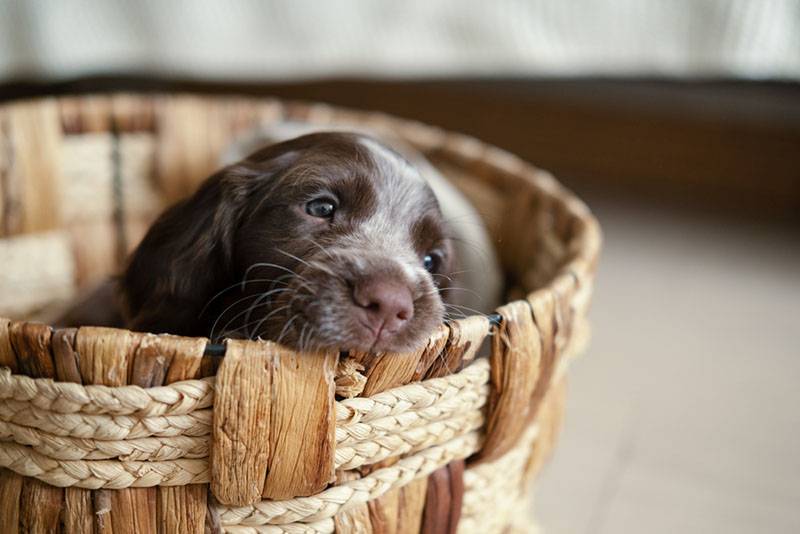
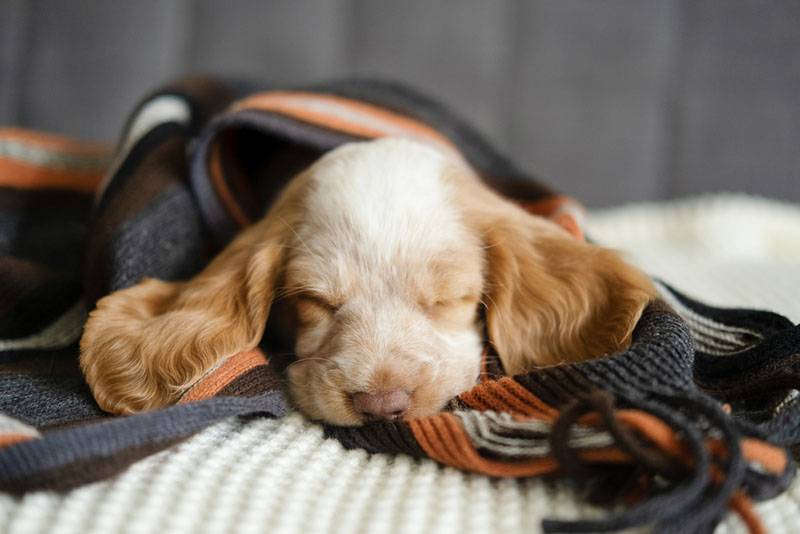
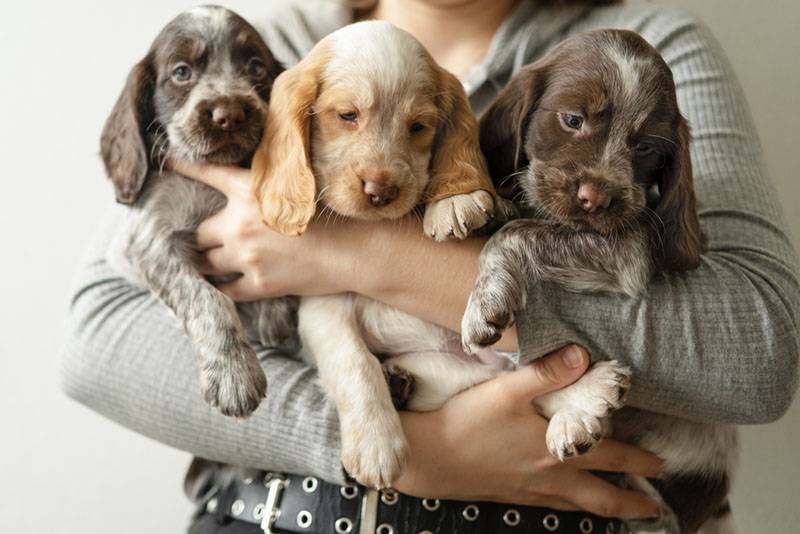
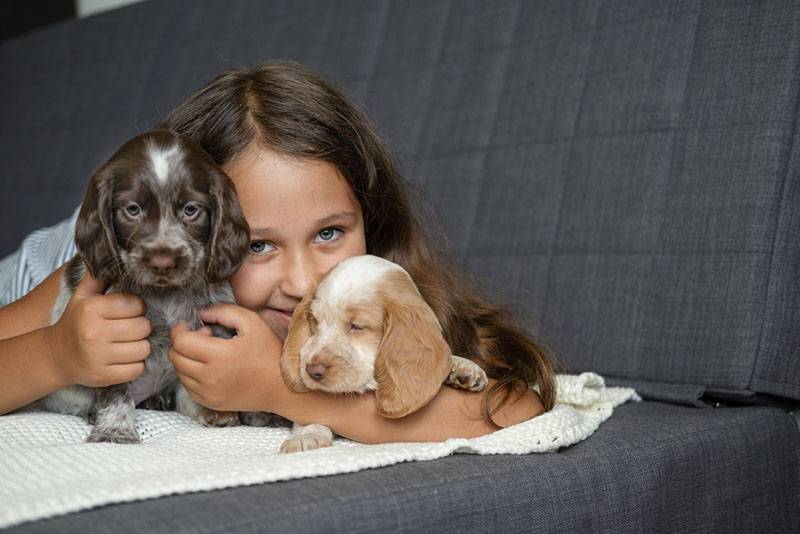
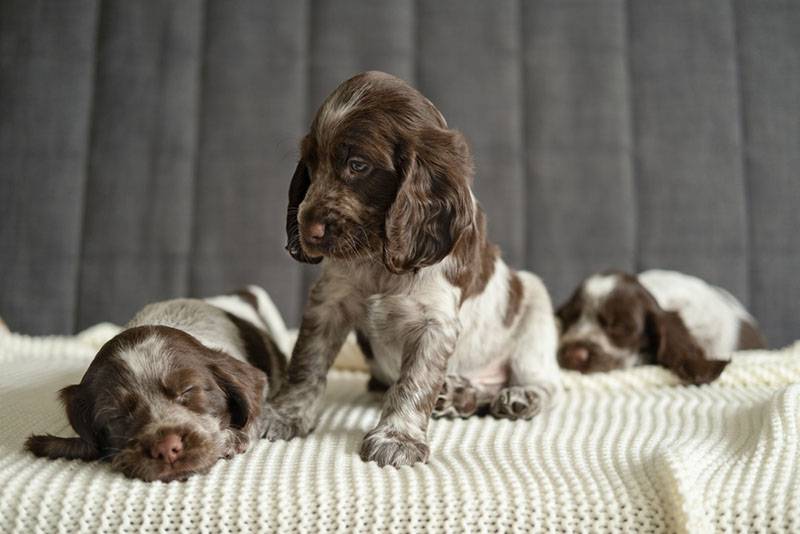
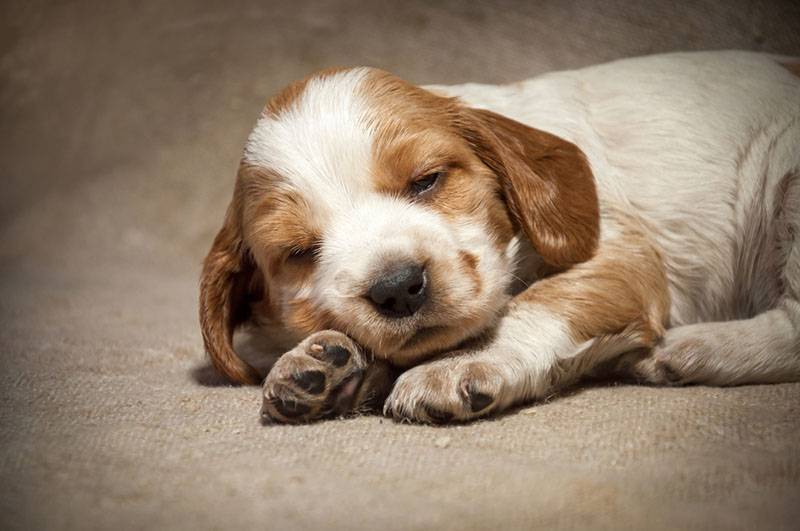
Owner’s personal experience
We carefully studied the impressions of the owners of this breed. Most owners of Russian Spaniels agree that they:
- Cheerful and active;
- They love children;
- They have excellent performance;
- Very beautiful;
- They have a high level of intelligence.
People are confident that the breed is suitable for the role of a family dog, because it gets along well with children of any age.
Owners of Russian Spaniels are advised to keep an eye on the pet, as he loves to pick up everything on the street and steal waste from the bin. The owner’s inattention to such a bad habit can lead to poisoning or more serious health problems.
The Russian Spaniel, according to most owners, has a great mind. He catches commands on the fly, performs with pleasure, especially for a tasty treat. Able to master all sorts of tricks. For example, throw dry food lying on the nose and catch it with your mouth.
Dogs are affectionate, love to be petted and hugged. Very playful. Favorite game is to bring a ball or other toy.
As a hunter, the Russian Spaniel is ideal for hunting birds. Swims great.
The most common health problem owners call inflammation in the ears. To prevent this from happening, you need to check them regularly and carefully.
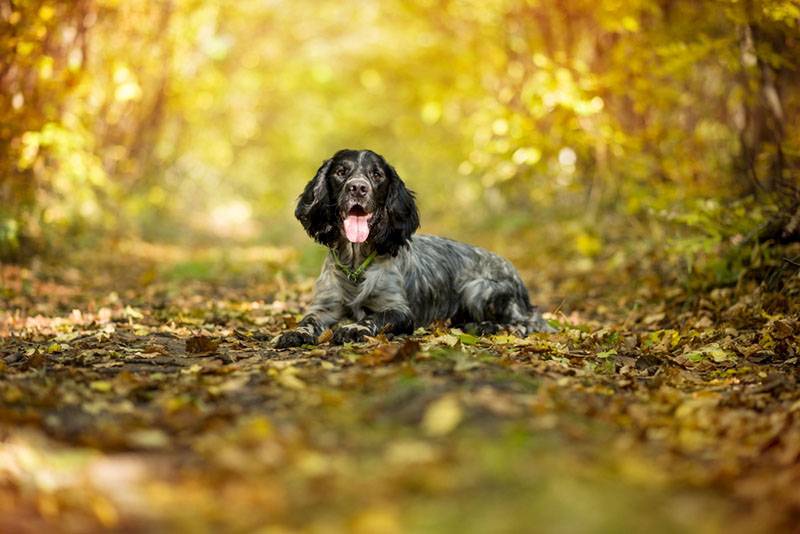
Cost of a Russian Spaniel
After talking with a large number of breeders, we found out that Russian Spaniel puppies can have a different price tag. It depends, first of all, on the experience of the breeder and the purity of the litter.
So, puppies born from healthy dogs cost 10-25 thousand rubles from private breeders. Often professional hunters are engaged in breeding.
In nurseries, the price tag is always higher – on average, from 35 to 45 thousand. Babies of Russian hunting spaniels, whose parents are purebred and certified dogs, can cost even more – from 50 thousand.
Video





